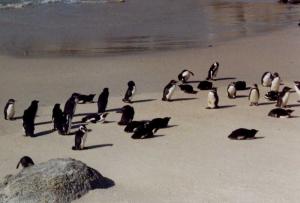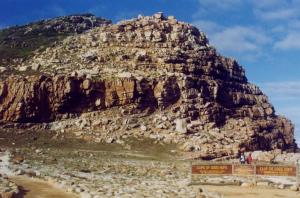Compared to a reluctant stop in Johannesburg, Cape Town is THE place most visitors to South Africa want to see. It was also the starting point of my seven-week overland trip. From here, I would travel all the way to Nairobi, Kenya. One of the countries along the way would become my 100th country.
Seven years ago, when I first visited Cape Town, I asked this question: Will Cape Town become the next glamorous place? With its beautiful mountains and oceans, mix of people in different colors and shades, it could easily become another Sydney or Rio. Seven years later, the answer is an obvious yes. Cape Town has been voted as the top 10 favorite destinations in the world by Travel and Leisure readers, two years in a row. Searching articles about Africa in the New York Times’ Travel Section, dozens of them are about Cape Town and surrounding region.
Crime and poverty are still causing problems (as they are in other parts of South Africa). However, Cape Town does emit a more relaxed atmosphere than other South African cities. And more important, it is easier to walk around town to appreciate street life.
My train from Johannesburg was two hours late, so it was practically dark when I checked into my inn. Even in Cape Town, it is not a good idea to walk alone at nights. Since I had spent almost all my rand on the train and cab fare in Johannesburg, I spent the night in my room (with barely enough money to get a beer at the lobby bar). I waited until the following morning to find the nearest ATM.
The fairest cape
I went on a day trip to the Cape Peninsula. Cape of Good Hope was thought to be the southernmost point of Africa. However, later it was discovered that the real southernmost point is at Cape Agulhas, almost 200 kilometers southeast of the Cape of Good Hope.
Driving along the valley between Table Mountain, still shrouded by "Tablecloth” this morning, and Lion’s Peak, we left City Bowl and reached the Atlantic shore. Passing several affluent seaside communities, with such names as Clifton, Camps Bay, Llandudno and Sandy Bay, we also went by some of the most majestic mansions in South Africa. The scenery was spectacular. Beaches were sandy, but I heard it was not suitable for swimming due to the cold Atlantic current. It reminded me of Florida’s Palm Beach and the French Riviera.
Later, we arrived at Hout Bay, where we boarded a small boat to see seals. Though seal viewing was fine, I was looking forward to another type of marine animal – penguins. After getting back to the shore, we continued to the eastern side of the Peninsula to visit these cute birds. Passing Simon’s Town, we got off at Boulders Beach. There were so many of them on the beach!
Because South Africa is still a long way from the Antarctica, penguins here tend to be smaller than the emperor penguins on Antarctica. Standing less than 60 centimeters (2'3") tall, these penguins are the smallest in the world, and they have quite a funny name – jackass penguins. Just watching them walking around, swinging with their little wings is enough to make us laugh. However, we were only allowed to watch penguins from the boardwalk. Naturally, it was prohibited to feed or touch them.

 Jackass penguins on Boulders Beach, the most
popular animals on the Cape Peninsula
Jackass penguins on Boulders Beach, the most
popular animals on the Cape Peninsula
Penguins and seals were not the only interesting animals on the Peninsula. We also saw baboons playing on the roadside when we drove closer to the tip of the Peninsula, Cape Point. Along the way, we noticed elands and ostriches. Though the whole Cape Town region has a strong European flavor, the wildlife reminded me that we were indeed in Africa. The ostriches are most likely domesticated, though. Driving further south, we entered the Cape of Good Hope Nature Reserve.
Francis Drake described Cape of Good Hope as "the fairest cape on the earth". The Portuguese navigator, Dias, named it in 1487. The Cape itself is often stormy and difficult to navigate. Nowadays, it is a popular tourist spot. Most travelers come to the Cape Town area as a ritual: to take pictures in front of the bilingual (English and Afrikaan) signpost: "Cape of Good Hope: The South-Westernmost Point of the African Continent". I took one too.
The scenery is dramatic, with rugged cliffs and unique stone formations. Some of the famous Cape Peninsula flora (called “fynbos” locally) can be seen around the moorland. It would be great to have a picnic here, watching the ocean and sky changing their colors. Getting on the bus, we continued to the end of the road – Cape Point.

 World famous Cape of Good Hope
World famous Cape of Good Hope
Getting off the bus at the end of the driveway, I had to change to a tram to go further. There was a lighthouse at the top of the hill. I reached the lookout point and after taking a few pictures, continued walking down a small trail. The trail turned into a even smaller path that led to Dias Point. I continued as far as I could, until I reached the end of the path – Cape Point. “No Access Beyond this Point", the sign read. Looking out with Atlantic Ocean on my right and False Bay (formerly misidentified as Indian Ocean) on my left, I was at the end of Africa, only an ocean between me and the Antarctica. My journey across Africa officially began.
Read more of Saricie Kuo's travels at his website.